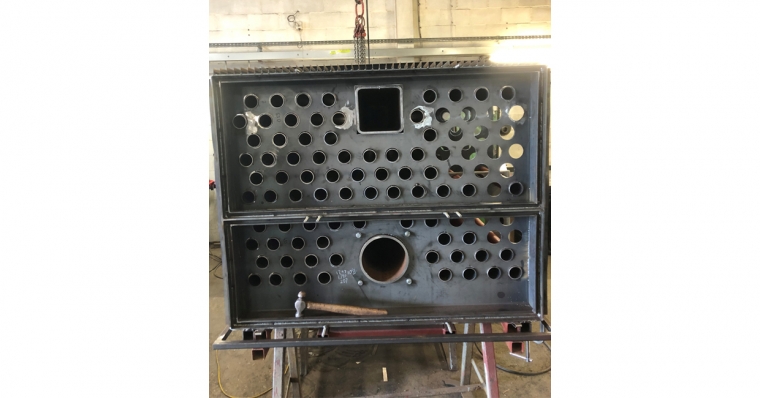Ranheat’s current 100 tonne seven-axis CNC Brake Press for folding metal has a 3m bed
Chris Franklin discusses Ranheat’s many attributes when it comes to sustainable manufacturing ...
Ranheat’s origins were in a small city in Denmark, called Randers. Denmark had no oil, no gas and no coal. The UK was, in contrast, an island of coal in a sea of oil.
Denmark’s lack of fossil fuels led them to utilise what was sustainable, in this case – wood and straw. With a cold sub-zero winter climate, wood and straw became Denmark’s fuel source, which led to a dependence on these fuels.
During the energy crisis in the 80’s the United Kingdom began to look at sustainable fuels, wood and straw, as an alternative to oil, mainly due to OPEC raising prices on the world market. So, the shift in the UK to renewables began out of rising costs, not the need for sustainability.
Ranheat Engineering Ltd. started manufacturing in the UK in 1990 for a number of reasons. Denmark was an expensive place to manufacture and shipping heavy bulky goods across the North Sea by ships was expensive. The rise in oil prices hit transport costs severely. Ranheat Energy A/S was unsustainable to manufacture in Denmark, so closed. Ranheat Engineering Ltd started manufacture in February 1990 and was 100% owned by Chris and Barbara Franklin.
New designs emerged using the Danish experience and know-how Chris had gained while working for the Danish Company. He then applied the technology but tailored the designs to suit manufacturing in a sustainable way in the UK.

Ranheat’s current CNC plasma cutter capable of cutting 25mm plate with easeRanheat Engineering Ltd establishes itself in the UK
The first step was to re-design the equipment around standard sheet sizes, to reduce waste of raw materials, then to invest in folding equipment, known as a Brake Press.
In the early days, metal was mainly cut using a guillotine, which restricted cuts to straight lines.
CNC plasma cutters were beginning to appear. These machines were able to cut metal up to 8mm thick in any shape that could be drawn on a computer. This enabled “tube nests” to be designed and cut.
High-definition plasma cutters are accurate to within 0.4mm, ideal for leaving a welding clearance around the tube nest holes.

300kW warm air tube nest with 95 tubes, 50mm in diameter cut out using Ranheat’s CNC plasma cutter. This multi-pass design gives a high thermal efficiency and low flue temperatures. This maximises the energy released from the fuel. Although using a waste as a fuel to maintain sustainability as much energy as possible is taken from the combustion process.
Energy costs during manufacture
To be sustainable in manufacturing, energy costs need to be considered. How much energy was used in the manufacturing of the metal sheet? How far did it travel to be delivered? How close is the local stockist? This is in addition to buying in an economic quantity, to ensure that the transport efficiency is maintained.
As far as tube nests are concerned, how many tubes can I cut from a standard length? All of these considerations are taken into account when designing Ranheat equipment.
Manufacturing in-house
To increase sustainability in manufacture, Ranheat try and manufacture as much as possible in-house.
This has led to the development of steel buildings manufactured from standard mild steel sheet sizes, profiled (folded) on the seven-axis CNC Brake Press to give the sheets strength, and painted for protection. The alternative would be a brick or block building to house the installation, which would mean using materials with a high carbon footprint.
As well as sustainability in manufacture, Ranheat also look at the sustainability of a system when in use. How long will the installation take to install? How many journeys will be needed to make the installation? How much fuel is used in making these journeys? Can the number of journeys be reduced if more of the system can be manufactured and delivered at one time? How many lorries are needed to deliver a system? Can this be reduced by good design and manufacture without compromising quality and reliability?
Storage silos for the wood-waste prior to combustion need to be sustainable in manufacture. The best designs in terms of storage versus material is to use a cylinder and a conical outfeeder to empty the silo. This only requires one small motor (0.75 kW0 and this is only running intermittently.
This design of silo maximises the storage capacity for a given utilisation of raw materials. It also gives a strong construction for longevity in service and low maintenance in use.
Control panels are also made in-house in Ranheat’s electrical department, again, to achieve sustainability. The more that can be made in-house the larger the reduction in transport and manufacturing costs. The use of inverters aims to reduce electrical consumption.
Continuing with the theme of sustainability in manufacture, pipework installations are drawn accurately in auto-cad and then the pipework is manufactured in-house to maintain quality and fit, once again reducing transport costs and labour.
01604 750005









